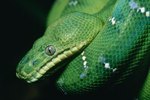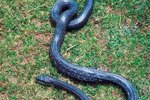
Colombia is rich with snakes, hosting at least six separate species and hundreds of subspecies, of which approximately 34 are exclusive to the nation, ranging from the small and harmless to the awe-inspiring. Colombia was once home to the largest snake to ever roam the earth, the so-called titanboa. Due to its varied geography, which includes rainforest, coastlines and savannas, Colombia provides the ideal habitat for a variety of different snake types.
Boas
At least eight boa species are found in Colombia, including the boa constrictor, the tree boa, the rainbow boa and the anaconda, the largest boa. It's unclear exactly how many species of boa exist inside Colombia's borders, because their habitats overlap with those of neighboring countries. Boas have the widest geographical range of Colombia's native snakes and can thrive in a number of different environments, including rainforest, woodland, grassland and semidesert habitats. They are excellent swimmers and are regularly seen in streams and rivers. Boas are nonvenomous. They kill their prey, which include bats, birds and any mammal which they can fit in their mouth, by constriction.
Ground Snakes
Most of the more than 80 varieties of ground snake can be found in Colombia and other South American countries, although it is unclear exactly how many are present at any one time due to habitats overlapping borders. These are slender, nonvenomous members of the Attractus genus. They vary in coloration and length, but ground snakes all dwell on the ground and are nonvenomous. They feed on small insects, birds and mammals. The prey each ground snake favors is determined by snake size and the environment in which the species or subspecies lives.
Coral Snakes
Coral snakes are widely distributed, found in Australia, Africa, Asia and the Americas. They are brightly colored, highly venomous members of the Elapidae family, which includes cobras. All Elapidae have short fangs at the front of the mouth that inject venom. Coral snakes are distinctive looking, with brightly patterned skin. This defining appearance serves well as a warning to would-be predators; other, nonpoisonous snake species mimic the coral snake’s appearance as a passive deterrent.
Pit Vipers
Pit vipers are venomous, ground-dwelling snakes characterized by two sunken pits on the face, above the nose. Pit viper species exist all over the world, and two can be found in Colombia; the chocoan toadhead pit viper and the lancehead, or fer de lance. These two snakes are highly venomous predators who feed on birds and small mammals. They typically inhabit lowland environments, such as forest and scrubland, but may also inhabit areas inhabited by humans, which accounts for the relatively high number of bites sustained by humans requiring hospital treatment.
References
Photo Credits
-
Jupiterimages/Photos.com/Getty Images
Writer Bio
Simon Foden has been a freelance writer and editor since 1999. He began his writing career after graduating with a Bachelors of Arts degree in music from Salford University. He has contributed to and written for various magazines including "K9 Magazine" and "Pet Friendly Magazine." He has also written for Dogmagazine.net.




